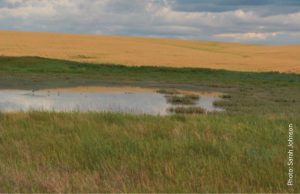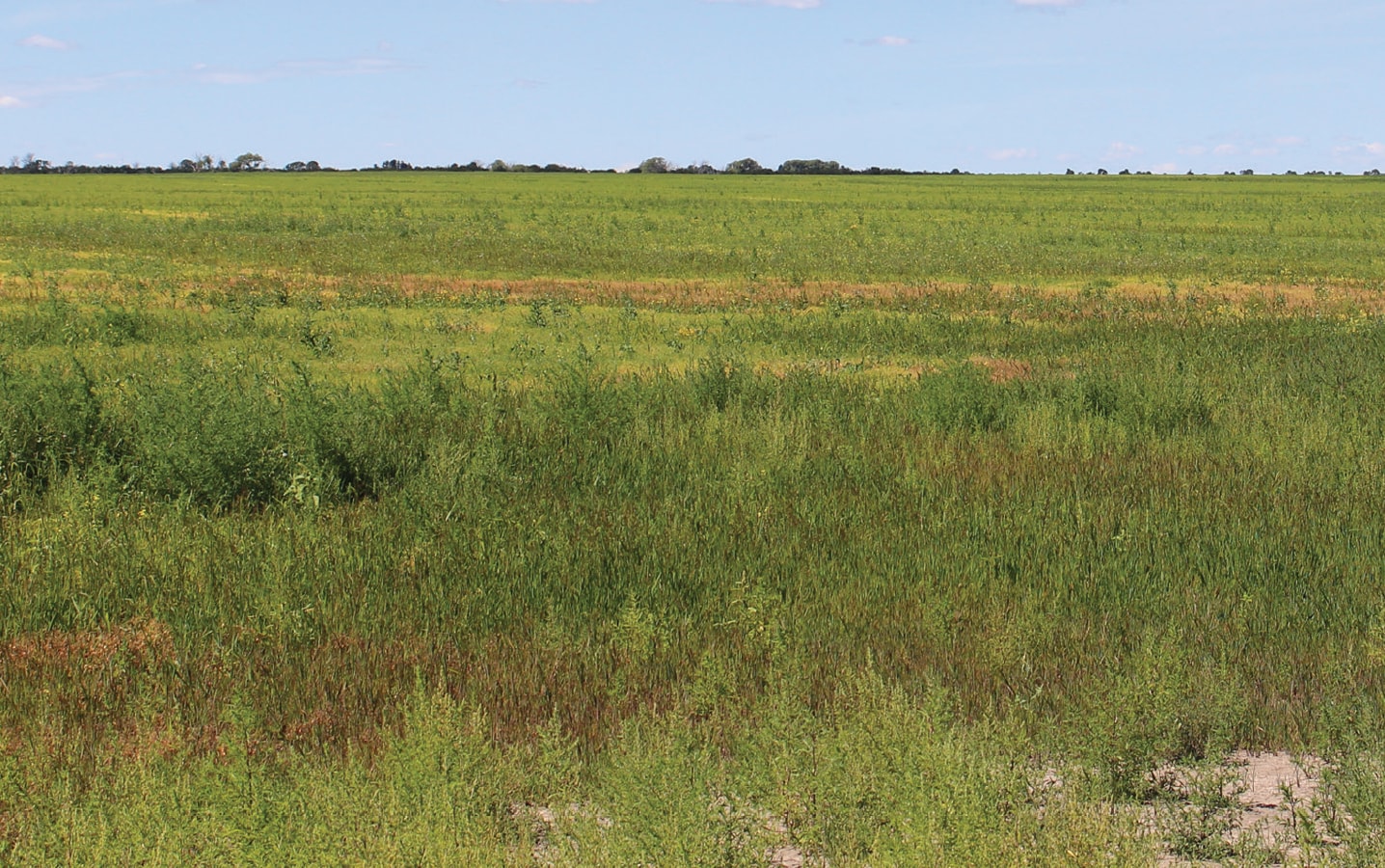What to do with acres that always lose money?
Farmers have three good reasons to take chronically unprofitable acres out of annual crop production. They are:
1. Stop spending money on acres that don’t provide a return. The costs of seed and fertilizer and weed control all add up. When saline, compacted, perpetually drowned out and weedy areas lose money year after year, maybe it’s time to target those acres for a long-term rest from annual crops. It will be good for your business bottom line and reduce risk.
2. Non-farmed spaces can increase yields for cropped acres. Ongoing research led by Paul Galpern at the University of Calgary demonstrates the value of the biodiversity provided by non-farmed spaces. While he doesn’t have concrete economic numbers at this time, Galpern can say this: “Evidence thus far generally supports the argument that non-cropped acres may seldom be detrimental, and sometimes be profitable.”
The gist is that taking these acres out of annual production and putting them into hay or trees, for example, not only stops the financial bleed from those acres, but the pollinators and beneficial insects present could improve yields for cropped acres. Of course, by matter of simple math, taking these poorest acres out of production will also increase the farm’s average yields and profitability.
Gregory Sekulic, Canola Council of Canada agronomy specialist, says shelterbelts, a staple feature of a biodiverse farmscape, have proven in various studies to increase yields. He points to research on soybeans done at Ridgetown College in Ontario, which showed a 10 per cent increase in yield on the leeward side of the trees. The area showing this yield benefit had a width equal to about 10 times the height of the trees. Sekulic also has his eye on brand new research, not yet published, from AAFC at Indian Head, Saskatchewan, which suggests a potential increase in seed oil content for canola plants within the shadow of a shelterbelt.
3. Slow the proliferation of weeds and disease. Failed efforts to push annual crops in poor producing acres can open the door to clubroot, kochia and more. Compacted field entrances and perpetual low spots are usually bad for crops, but can be hot spots for clubroot. Weeds that thrive under low crop competition, like foxtail barley, or that grow better than other plants in less productive areas, like kochia, tend to take over. So not only do you have less crop, you also have a higher weed management cost. Putting these areas into a perennial grass would nail down the clubroot spores and maintain permanent competition for kochia, foxtail barley and whatever other weeds run wild.
Curtis Rempel, Canola Council of Canada vice president for crop production and innovation, says we’re finally starting to put economics to these land use decisions. “Evidence is starting to show that some acres become more productive when they’re used to support natural habitat instead of growing annual crops,” he says. “We suspected this all along, but now we’re getting the tools to actually measure it.”
How do you identify unprofitable acres?
The simple method is to seed field entrances, erodible water runs, saline, wet and weedy areas to perennial forage. You don’t need yield maps to identify these areas.
The almost-as-simple step is to overlay a few years of yield maps with input expenses to identify areas that never generate a profit.
The advanced step is to bring in professional help. Mike Wilson is the affiliate program lead for Veritas, an Ontario-based consulting company that helps ag retails offer precision ag tools, like profit mapping and variable-rate prescriptions, to their customers.
Wilson uses yield maps and grid soil sampling to help farmers identify profit zones within each field and manage them with variable-rate fertilizer. He divides fields into four zones – and possibly five zones for those willing to take the big step of grassing-in unprofitable acres. Here are his zones:
- Zone 1: Good-yielding acres with good soil nutrient levels. In these zones, Wilson recommends that farmers fertilize to match crop removal.
- Zone 2: Good-yielding acres with poor soil nutrient levels. “Productivity in these areas will get steadily worse, so we need to turn the dial up on fertilizer rates,” Wilson says. “These acres will reward us for spending the extra money.”
- Zone 3: Poor-yielding acres with poor soil nutrient levels. These areas might be fixed with more fertilizer or lime, he says.
- Zone 4: Poor-yielding acres with good soil nutrient levels. “These could be saline areas, water holes or sand holes that need steady rain to be productive,” he says. The crop productivity in these areas is just too poor to make use of the inputs invested. The approach here, Wilson says, would be to cut off or vastly reduce nutrient inputs as a way to improve profitability in these areas. But can they ever be profitable?
- Zone 5: If the answer is no, then these acres could drop into Wilson’s Zone 5, which would take them out of annual crop production.

Wilson rarely recommends Zone 5 treatment, mostly because farmers aren’t that receptive to the idea.
“This is often a stumbling block for farmers who are paying rent on these acres and feel like they should be doing something with them – even if these acres never make money,” he says.
Putting cropland into perennial grass or forages may require specialized equipment, a nearby market for forages, and advanced seeding and spraying tools to shut off everything and lift the tools when passing over these spots.
Having said that, Wilson does see the point in setting aside the worst of the worst if a farm has a good plan for those acres. “If those acres always lose you money, you might ask, ‘why am I continuing to farm this land the way I’m farming it?’”
Rempel adds, “If yields from those Zone 5 areas doesn’t cover the input costs, farming these acres doesn’t reduce the tax burden, it just makes the situation worse.”
With any field zone discussion, Wilson starts by asking the farmer: “Are you willing to change?”
Moving toward profit mapping means an investment in more intense soil sampling, variable-rate or sectional control fertilizer and herbicide application capability, and the wherewithal to take chronically unprofitable zones out of production.
How do you set aside unprofitable acres?
Ideally, growers would have a low maintenance and long-lasting grass to put into those set-aside acres. Calvin Yoder, forage seed specialist Alberta Agriculture and Food, says “one low-maintenance, low-cost species that comes to mind is sheep’s fescue.” As a bunch grass, it won’t creep into the field, plus it’s hardy and “pretty tolerant to a number of herbicides,” he says.
Yoder says a lot of tree nurseries and orchards use sheep’s fescue around their trees for all of these reasons. He’d actually like to see more sheep’s fescue seeded around field edges and in field approaches to keep the sprayer booms out of the ditches and keep perennial ditch weeds from creeping into fields.
He provides a few tips to establish sheep’s fescue or any other low-maintenance grass: It is nice to start out on canola stubble. Give the area a pre-seed herbicide application. Seed with a drill or broadcast the seed over the canola stubble early in the spring. Harrow the area to cover the seed with to no more than a half an inch of soil. Add some fertilizer at the time of seeding to improve establishment.
For more tips on establishment and managing forage stands, Yoder says the Saskatchewan and Alberta forage guides are useful resources. Find them at the provincial ag department websites.
Rempel sees the benefits of low-cost, low-maintenance grasses as an alternative to annual crops on those unprofitable acres. He says the ideal species or mix will meet a variety of needs, including low cost and low maintenance. “Namely, it will not host clubroot, it will attract pollinators and it will provide other ecosystem services that improve crop yields and promote beneficial insects,” Rempel says. In the end, this species or mix will convert chronically unprofitable acres into spaces that actually help the farm.





